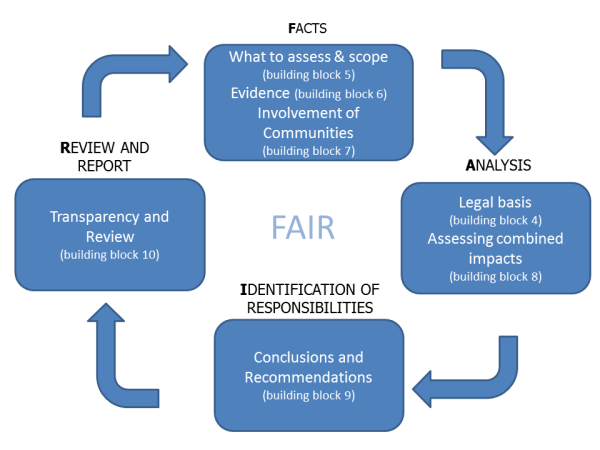Case Study 1: Refocusing social care provision
A local authority decides to re-define those who are ‘in need’ of social care in their own home. Those agreed to be in high need of care will continue to receive it free of charge but criteria for charging fees for services for those in lesser forms of need will be introduced as an attempt to increase income and lower demand.
Although the need to rationalise and reduce expenditure is the primary driver for this policy the social care team also believe that resources could be better targeted at those in highest level of need and thus increase entitlements for some.
The authority has developed options and draft criteria for different levels of need in preparation for a consultation in advance of a decision by elected members. As this policy is directly relevant to both equality and human rights of both users and carers of the current and future services, they decide to conduct an EQHRIA.
Task
How should the local authority proceed? Using the questions below, follow the FAIR model to develop your response:
Facts: What are the important facts?
Are there specific, potentially disproportionate, negative impacts on particular groups including those with protected characteristics?
Which individuals and groups need to be heard?
What sources of evidence (qualitative and quantitative) could be used to assess the current and future impacts of the policy options?
When gathering the facts:
-
What methods would you use to ensure that those affected by the policy are consulted and involved in decisions that affect them, in an active and meaningful way?
-
Can you identify any of the individuals or groups who are likely to need support to engage with you, and if so, who will provide that support?
-
What information will those affected by the policy need in order to be able contribute effectively to the consultation process?
Analysis: What are the human rights at stake and what are the implications of the policy for compliance with the Equality Act?
-
What are the human rights issues at stake?
-
Are the rights absolute?
-
Can the right be restricted and if so, what is the reason for the restriction in this case?
-
If the right is being restricted, is the response proportionate? (i.e. is it the minimum restriction necessary to achieve your objective – or is it a “sledgehammer to crack a nut”?)
-
From the evidence gathered are the protected groups likely to be treated less favourably than others by the policy?
-
If the policy applies to everyone, are the protected groups likely to suffer a particular disadvantage compared with other groups?
-
Is the policy designed to achieve positive benefits for protected groups? For example, will the policy remove or minimise disadvantage, meet particular needs or encourage participation?
-
What is the potential impact on “good relations" - that is the “promotion of understanding and the reduction of prejudice.”
Identification of shared responsibilities
-
What changes if any, are necessary to the policy that would mitigate any negative impact of the policy?
-
Who has responsibilities for helping with any necessary changes?
Review actions and policy
-
Have the actions taken been recorded?
-
How often, and in what circumstances, will the policy be reviewed and by whom?
FEEDBACK CASE STUDY 1: REFOCUSING SOCIAL CARE PROVISION
An important fact in this case is that although the need to reduce expenditure on social care has been initiated by the national government, the local authority has the responsibility for deciding how that will be implemented. They will need to ensure that the impact of the policy does not disproportionately disadvantage any of the groups with shared protected characteristics as well as ensure the human rights of those affected are protected.
The groups most likely to be affected by the potential reduction of services include disabled people and older people, especially the very elderly.
Women are disproportionately represented within the older age groups because they live longer. Women are also more likely to be the carers, both paid and unpaid, and the reduction in services is likely to require them to take on extra unpaid caring work which will impact on their availability to carry out paid work
The key human rights engaged are:
-
Right to life (Article 2 HRA): there is a particular danger to the elderly of a reduction in services even for those whose care needs have been identified as low or moderate;
-
Right not to be tortured or treated in an inhuman or degrading way (Article 3 HRA): the withdrawal or reduction of services could endanger the lives of those who are already vulnerable.
-
Right to respect for private and family life (Article 8 HRA): an increased number of people may have to go into care homes because social care at home is no longer available and the physical and psychological integrity of those who require care but are not deemed to be in high need may be impacted.
Those who should be consulted include those currently receiving or needing care, unpaid carers, friends and family, staff who provide the care, other health and social care professionals and groups who represent the interests of those in care.
The consultation and the evidence from other sources might lead the authority to either reconsider their decision or to put in place some mitigation measures to deal with the negative impacts, for example, setting up emergency service so that carers can obtain priority consultation over medical treatment for service users where required and ensuring that he existing help-line for people needing care and carers is given more information to sign-post other sources of care.



